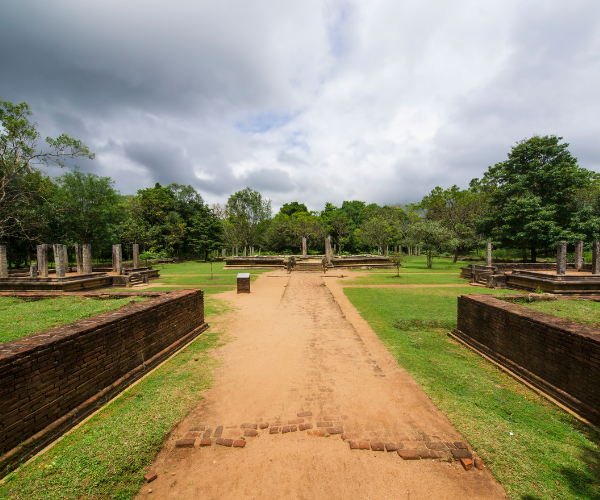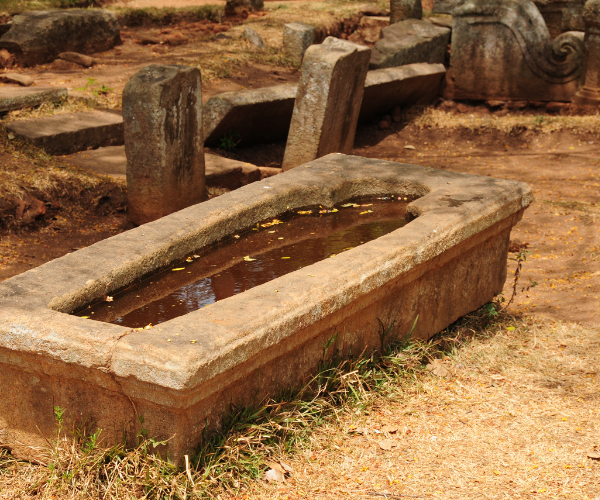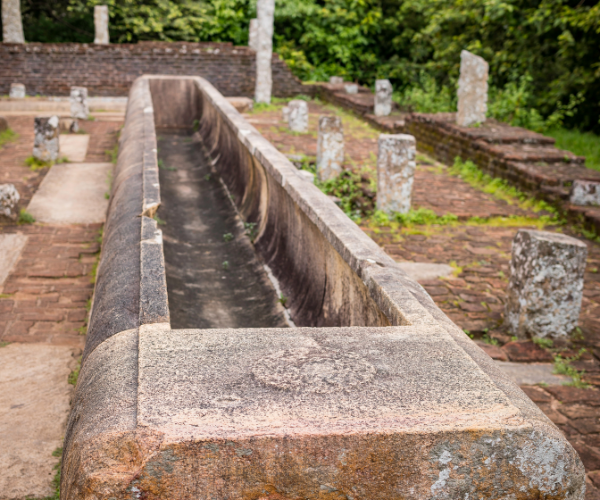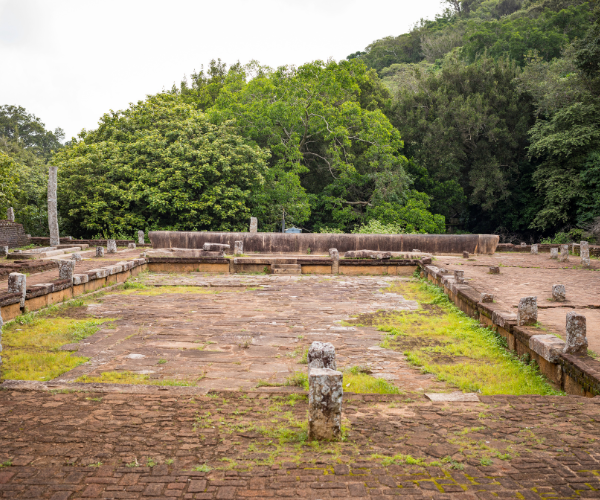Mihintale ancient Hospital – the oldest in the world? – By Arundathie Abeysinghe

 Established by King Sena II (853-887 AC) at *Mihintale around 853 A.D., the ancient hospital in the location is considered as the oldest in the world, although, consulting and healing have taken place in the location centuries before. According to inscriptions, Ayurvedic medicine has been practiced at Mihintale and the hospital has been maintained by Buddhist monks. The layout of the building (of the hospital) and discovery of a medical trough are also evidence that a hospital had existed at the site.
Established by King Sena II (853-887 AC) at *Mihintale around 853 A.D., the ancient hospital in the location is considered as the oldest in the world, although, consulting and healing have taken place in the location centuries before. According to inscriptions, Ayurvedic medicine has been practiced at Mihintale and the hospital has been maintained by Buddhist monks. The layout of the building (of the hospital) and discovery of a medical trough are also evidence that a hospital had existed at the site.
The oldest archeological evidence of a hospital in Sri Lanka is within the ruins of Mihintale. The identification was based on a 10th century inscription at the site. According to the plan of the hospital, there had been 31 rooms and these rooms were arranged on a high platform. The consulting room, rooms for hot water baths, inner verandah, court yard, outer court and a room for medicinal bath had been there in the Hospital Complex. In addition, steam therapy utilizing hot water had also been utilized as a form of treatment. Beds for patients had been arranged around the outer courtyard. Cisterns had been utilized to supply water to the hospital. There had also been a dispensary close to the entrance.
According to *Mahawamsa, ancient Sinhalese have introduced the concept of hospitals to the world. Scholars are of the view that *King Pandukabhaya (474 BC – 367 BC) had also *lying-in homes and treatment centers known as “Sivikasotthi Sala” (hospitals) constructed in several parts of the country.
Known as “Vejja Sala” (meaning Hospital), the hospital dates to the 3rd century AD, approximately 400 years before the earliest hospital in Europe existed. Scholars are of the view that among the remnants of walls and pillars, there are monolithic stone baths hewn from a single rock which have been utilized to treat patients in the hospital. These stone baths have been made with a remarkably gripping sculptural quality and the internal cavity has been shaped to immerse a recumbent body without wasting precious herbal oils. Several stones utilized for grinding medicinal herbs and medicine jars unearthed from the site are preserved in the adjacent museum.
Several blue glass jars (believed to be from Persia) as well as surgical instruments have also been unearthed from the site during archaeological excavations. Hence, scholars are of the view that advanced surgical skills had existed during this period, hitherto unknown in many parts of the world.

According to scholars, there is no evidence to indicate that hospitals were known elsewhere before and during the time of King Pandukabhaya. Scholar Heinz E Muller-Dietz (Historia Hospitalium 1975) has described Mihintale Hospital as being perhaps the oldest in the world.
Although, the hospital had been constructed during the period of King Sena II around 853 A.D., healing has taken place at the location much earlier as several ancient Sri Lankan Kings were well versed in Ayurvedic medicine. Herbs and spices had been used for treatment.
There had been many pioneering Sri Lankan Kings who has served as doctors in the past. King Buddhadasa (A.D. 340-368), the renowned physician-king was adept in general medicine, surgery, midwifery as well as veterinary medicine. According to chronicles, the King had excelled in surgery and had performed a surgery for a woman (to deliver her child). The King had also carried out a surgical removal of a lump in the belly of a snake. According to Mahawamsa, the King had constantly carried a set of surgical instruments during his journeys. According to *Culawamsa, King Aggabodhi VII (766-772 A.D.) has conducted research pertaining to medicinal substances.
Treatments at Mihintale Hospital has followed the principles of Ayurveda and the hospital had been run by Buddhist monks.
There is a stone sarcophagus near the hospital entrance, considered as a tomb of a small person. The hospital had been well-known for herbal treatments and the stone trough is a bath where patients were immersed in oils and herbs and one of the most common disorders treated in the stone bath had been for snake bite. At present too, ayurvedic medicine is utilized to treat snake bites in Sri Lanka.
The inner part of the Complex had been utilized for living. Daily alms had been brought by pious laymen to the hospital to be blessed by Buddhist monks to the inner court. Rice and porridge bowls have been excavated from this location of the hospital.
At the entrance to the hospital is the outer courtyard comprising four rooms: consulting room; room for preparation and storage of medicine and a room for hot water baths. Towards the end of the outer courtyard, to the north is the main building, the quadrangular courtyard with a small shrine in the center. The rooms are arranged on a high platform on all four sides of the Central Courtyard. The rooms face the shrine which is in the Courtyard. The size of each room is approximately 100 square feet (approximately 9.2 square meters). Towards southern side of the Complex, there is an outer court comprising the hot water and steam baths, a clinic, the refectory, a medicine stores and a grinding stone that has been utilized to grind medicine.
At present, there are stone pillars in the hospital ruins.

- Anuradhapura – A major city in Sri Lanka (former Ceylon), the capital of Anuradhapura District. Anuradhapura was one of the ancient capitals of Sri Lanka and is famous for its well-preserved ruins of Sri Lankan civilization. Founded in the 4th century, Anuradhapura was the capital of Sri Lanka until the beginning of the 11th century. Anuradhapura is considered sacred to Buddhists and there are monasteries, stupas within an area of 40 square kilometers. Anuradhapura was declared as the “Sacred City of Anuradhapura” and a World Heritage Site by UNESCO in 1982.
- Arhat Mahinda – The profoundly sapient Thera arrived in Sri Lanka (former Ceylon) as requested by his father, Emperor Asoka of India (264-267 BC). With the advent of Arhat Mahinda and establishment of Buddhism in Sri Lanka, a socio-religious revolution took place in the country changing the life, culture and civilization of people.
- King Devanampiyatissa (306 BC – 266 BC) – During his reign, Buddhism was introduced to the country. The King is considered as one of the most notable monarchs. During his reign, many significant temples and stupas were constructed as Buddhism was rapidly taking root in the country. Two significant ancient monuments, *Vessagiriya also known as “Issarasamanarama” and *Isinbassagala Ruwangiri Rajamaha Viharaya were constructed during King Devanampiyatissa’s preriod.
- King Pandukabhaya (474 BC – 367 BC) – King of *Upatissa Nuwara and the first monarch of the *Anuradhapura Kingdom. He was the son of Unmadha Chitra (Queen Suwarnapali) and Prince Digha-Gamini and the grandson of *King Panduvasudeva. According to chronicles, Kingdom of Anuradhapura thrived under his reign and the country’s capital was changed to Anuradhapura. King Pandukabhaya established a great city where “Anuradha Gama” was located and named it as “Anuradhapura.” During his reign, many villages, castles, sewer systems, hospitals and cemeteries had been constructed.
- King Panduvasudeva (504 BC to 474 BC) – The first monarch of the Kingdom of Upatissa Nuwara, a nephew of *Prince Vijaya. He had 10 sons including Abhaya and Tissa and one daughter, Unmada Chitra.
- Lying-in homes – A private home or hospital where mothers could give birth assisted by a midwife – a place utilized for postpartum confinement and for traditional practice including long bed rest before and after giving birth.
- Mahawamsa – “Great Chronicle” or “Great Dynasty” in Sinhala is the most significant work of Sri Lankan origin written in Pali Language. This Chronicle describes life and times of Sri Lankans from the arrival of Vijaya in 43 BC to the reign of King Mahasena from sixth century BC to fourth century AD. Culavamsa (lesser chronicle) covers the period from fourth century AD to British takeover of Sri Lanka, in 1815. Mahawamsa consists of three parts covering a historical record of over two millennia. It is considered as the world’s longest unbroken historical record.

- Mannar – Situated in the Northern Province of Sri Lanka, Mannar consists of an area which is part of the mainland as well as Mannar Island, the largest islet in the country. Situated in the Dry Zone of Sri Lanka, the landscape of Mannar is varied; wooded jungles to paddy fields and palm trees. According to legends, Mannar Island had served as a connection to the southern tip of India in the past.
- Mihintale – Mihintale, literally meaning “Mahinda’s Hill” (in Sinhala) and considered as the birthplace of Buddhism in Sri Lanka is a mountain peak near Anuradhapura. According to chronicles, the mountain peak is believed to be the location of a meeting between *Arhat Mahinda and *King Devanampiyatissa where the King was converted as a Buddhist, thereby establishing Buddhism as the island’s state religion. Thereafter, Buddhism has been immediately embraced by the Sinhalese and it was firmly established in the island, unlike in India, its birthplace.
- Prince Vijaya (c. 543 – c. 505 BCE) – According to *Mahawamsa, he was the first Sinhalese king. Indian and Sri Lankan legends and records indicate that he and several hundred followers arrived in Sri Lanka after they were banished from Sinhapura (Sinhapura – transliterated as Sihapura or Singhapura – capital of the legendary Indian King Sinhabahu) in India.
- Upatissagama – The second capital of the Kingdom of Tambapanni founded by King Vijaya (former Prince Vijaya) and 700 of his followers after landing in Sri Lanka in an area near current *Mannar during the Pre *Anuradhapura period. Upatissagama meaning the village of Upatissa, established by Upatissa, a follower and senior minister of *Prince Vijaya.
Isinbassagala Ruwangiri Rajamaha Viharaya – temple with historical significance – By Arundathie Abeysinghe – Sep 30, 2022
Vessagiriya – reminiscent gravity-defying boulder with inscriptions – By Arundathie Abeysinghe – Nov 23, 2022







